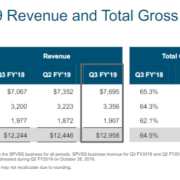Pour gasoline on a fire and you get a reaction. It's a simple matter of physics. That is the natural result of hitting the economy with tax cuts, fiscal stimulus, and low interest rates all at once. But at what price?
Of course, the headline number of the week was the first read on Q2 GDP growth, which came in at a strong 4.1%, the hottest number in four years. What was one of the biggest contributors? Soybean sales, as buyers rushed to beat the imposition of retaliatory Chinese tariffs. Consumers also hit the stores hard, spending their rising by a robust 4%.
The big question now is how much of this is sustainable? The answer is probably not much, which leaves investors with the queasy feeling that by coming in now they risk buying the absolute peak in the stock market. By temporarily pulling forward so much growth you may be creating a growth hole in Q3. So better mark your calendars now.
Q2 almost always delivers a string rebound from a usually weak Q1. The tax cuts delivered a one-time-only boost. But the investment spending that the administration had hoped for hasn't materialized, with a disproportionate portion of corporate profits going into share buybacks instead. Inventories are rising sharply, which is always bad.
We'll know for sure in a year when a recession will most likely begin. And remember, this extra growth is at the expense of an increase in the national debt by 10%, from $21 trillion to $23 trillion. And that is definitely NOT sustainable, but everyone in the world seems to have forgotten that, except me!
Interestingly, the report placed the current inflation rate dead on the Fed's target at 2.0%. That is a guarantee that any continued economic strength will be offset by rising interest rates.
The Facebook (FB) earnings highlighted the poor risk/reward of buying tech stocks at these elevated levels. Facebook shares plunged by 20% on their earnings announcement, creating the largest single day loss of market capitalization in history, some $120 billion. It was obviously a "kitchen sink" quarter.
If you get an earnings beat, as you did with Microsoft (MSFT) and Amazon (AMZN), you get a 2-, 3-, 4% pop in the stock price. If you disappoint, as did Facebook, Netflix (NFLX), and Twitter (TWTR), they crater by 10% to 20%. It is all typical end-of-cycle price action.
On the other hand, Amazon knocked the cover off the ball with its earnings, which came in at double analyst forecasts. The company is about to reach my end 2018 target of $2,000 a share. That is double the February lows.
Amazon Web Services delivered a stunning $6.1 billion quarterly revenue, up 49% YOY. Advertising is now becoming a major factor, as the company challenges Google (GOOG) and Facebook. For more on the longer-term prospects of Jeff Bezos's incredible company please see the special report that I published yesterday.
Bonds (TLT) continued their moribund price action, barely eking out a gain in yields to 2.97%. Either they are already discounting the next recession, are flooded with cash from a global QE hangover, or are getting a nice flight to safety bid brought on by multiple trade wars. Most likely it is all three.
Better to opine from the sidelines than to attempt to trade in the least volatile bond market conditions in 30 years.
As for gold, it continues to be a trader's worst nightmare as it plums new 2018 lows. Clearly, globally rising interest rates are not of what bull markets in gold are made. It doesn't help that Venezuela continues to hammer the market by liquidating its entire gold reserves on its way to national bankruptcy. Whenever distress liquidations take place, they are bad for everyone, not just the seller. Competition from crypto currencies for the speculative dollar doesn't help either.
As I have been sitting on top of an Alp contemplating the future and out of the markets, my 2018 year-to-date performance remains unchanged at an eye-popping 24.82% and my 8 1/2- year return sits at 301.29%. The Averaged Annualized Return stands at 35.10%. The more narrowly focused Mad Hedge Technology Fund Trade Alert performance is annualizing now at an impressive 38.69%.
It will be a big week on the data front, with an FOMC Meeting and an onslaught of jobs data.
On Monday, July 30 at 10:00 AM we obtain the June Pending Home Sales.
On Tuesday, July 31 at 9:00 AM EST, then we get the May S&P CoreLogic Case-Shiller National Home Price Index.
On Wednesday, August 1 at 2:00 PM, the Fed announces its decision on interest rates. Given the hot 4.1% Q2 GDP report, another 25-basis point rate rise is entirely possible.
Thursday, August 2, leads with the Weekly Jobless Claims at 8:30 AM EST, which saw a rise of 9,000 last week to 219,000.
On Friday, August 3 at 9:15 AM EST we get the July Nonfarm Payroll Report. Then the Baker Hughes Rig Count is announced at 1:00 PM EST.
As for me, the highlight of the week was being handed the keys to the City of Zermatt by the mayor for visiting for the 50th year. Yes, I camped out here at the Youth Hostel in 1968. Also, with the honor came a Swiss Army knife with my name on it and a beautiful 10-pound coffee table book outlining the route I usually take to the Matterhorn summit.
I am now contemplating my return to the U.S., which is always hellish. It will require two trains (to Visp and Geneva), two flights (to Amsterdam and San Francisco), the last one of which lasts a punishing 10 1/2 hours. Then there is the eight hours of jet lag to deal with when I get home. So, I'll be getting up at 2:00 AM for a while. During those days I will be posting some of my favorite pieces from the past.
Still, to see the 14,692-foot Matterhorn from where I am sitting in the brilliant sunshine in all its glory, listening to an Alpine river rushing outside my window, and watching the swaying pines, it is all worth it.
Good luck and good trading.









